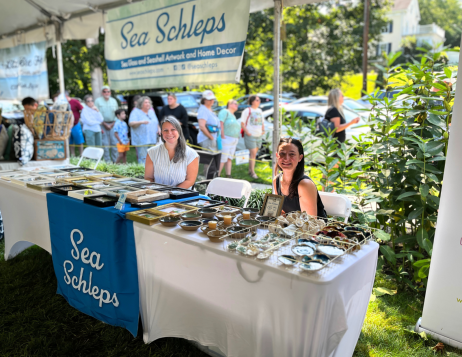The Whaling Museum and Education Center in Cold Spring Harbor has announced the return of its Sea Glass Festival, which features an array of new activities and enriched experiences for the 2024 season.
Set to take place on Sunday, July 21, from 10 a.m. to 5 p.m., this popular family-friendly event will celebrate the history, artistry, and allure of sea glass, now with an expanded presence on historic Main Street in Cold Spring Harbor. The event is the only one of its kind in the region and is the museum’s largest community event which welcomes 1,000 attendees. It is supported in part with funds awarded through a grant from Suffolk County Economic Development and Planning.
“We are thrilled to bring Long Island’s exclusive Sea Glass Festival to our community for the third year in a row,” said Nomi Dayan, Executive Director at The Whaling Museum & Education Center. “Sea glass, along with the historic glass bottles in our collection, are unique portals into Long Island’s stories. This year, we are excited to offer a number of expanded opportunities for both adults and children to appreciate and learn about the glass gems created by the ocean that surrounds us.”
Event Highlights:
- Expert Presentations: Learn about sea glass and historic glass bottles.
- Live Music: Enjoy tunes by Rorie Kelly.
- Shopping: Browse booths with sea glass-themed artworks and crafts.
- Contests & Crafts: Enter the sea glass contest and participate in fun crafts.
The festival will present an extended schedule featuring talks and lectures delivered by sea glass experts, historians, authors, and artists. These engaging sessions will be held in the museum’s gallery and offsite at a neighboring event partner, Preservation Long Island, situated a 5-minute walk from The Whaling Museum.
“Our staff curated an exciting lineup of both returning and new presenters who will provide valuable insights and inspiration to our attendees. Our presenters’ expertise and passion for sea glass and beachcombing will help educate the public on topics such as identifying sea glass, the history of local glass, and the creative applications of sea glass,” said Dayan.
Speaker presentations at Preservation Long Island will take place at 11 a.m., noon, 1 p.m. and 2 p.m., with two presenters alternating: George Wm Fisher, author of multiple books on Long Island’s bottles and medicine companies, will present at 11 a.m. and 1 p.m. on “The Origins of Sea Glass.”
Mary McCarthy, Beachcombing Educator and former Executive Director of The Beachcombing Center, will present next at noon and 2 p.m. on the “Difference between Fake and Genuine Sea Glass.” Mary will also host her celebrated “Beachcombing Table” and offer sea glass identification for the public when she is not presenting.

New for 2024:
- Expanded Presentations: Lectures on sea glass history at the historic Old Methodist Church, home of Preservation Long Island.
- Mobile Beachcombing Museum: Explore “Tumbled By The Sea.”
- Sea Glass Hunt: Find hidden sea glass on Main Street to enter a prize raffle.
- Shadow Box Craft: Create a unique sea glass craft for $10.
- Special Drinks: Enjoy sea glass-themed drinks at Sweetie Pies on Main.
Additional new activities that extend into historic Main Street in Cold Spring Harbor include: a scavenger hunt down Main Street; an exclusive visit to the Cold Spring Harbor Firehouse Museum; and the option to purchase a new sea glass-themed beverage from Sweetie Pies on Main.
In The Whaling Museum’s gallery, festival attendees can attend new talks held every hour from 10:30 a.m. to 3:30 p.m. Speaker highlights include Amy Dries of “Tumbled by the Sea,” a mobile museum that will be stationed in front of the festival tent, and author and historian Roxie Zwicker who will be discussing her new book, “New England Sea Glass: A Vibrant History.” A full schedule of talks and presentations is available at cshwhalingmuseum.org/seaglass.
Outdoors at the festival, attendees will have the chance to explore the mobile exhibit “Tumbled by the Sea” and take a self-guided tour of this travelling museum, shop with over a dozen artists and exhibitors under the tents including new artists and returning exhibitors, and view glass art torchwork demonstrations with Ro’s Glass World.
Kids can partake in a sea glass scavenger hunt in the museum’s gallery and enjoy complimentary crafts included with admission.
Live music by artist Rorie Kelly will add to the festive atmosphere, who performs fun, family-friendly crowd-pleaser music from the 1950s to today.
Returning again will be the Sea Glass of the Year contest, now featuring a new kids category.
Moreover, this year’s festival introduces a new Sea Glass Writing Contest for Long Island youth in partnership with TBR News Media. Festival attendees can hear the entries of contest winners at the event.
Attendees wanting to explore their creative side can create a new shadow box craft in the museum workshop facilitated by museum educators. Tickets for this add-on craft can be purchased only at the event inside the museum’s gallery.
When hunger strikes, festival attendees can enjoy offerings from the All-American Wontons food truck which will be on-site or visit any of the restaurants and cafes in Cold Spring Harbor, including Grasso’s Restaurant, Sandbar, Harbor Mist, The Gourmet Whaler and the Cold Spring Harbor Deli.
The Whaling Museum and Education Center is located at 301 Main Street in Cold Spring Harbor. Online tickets for the Sea Glass Festival are priced at a discount for advance purchase at $15 for attendees and $10 for museum members. Door tickets will be available at $20 for attendees and $15 for members. For more information, visit www.cshwhalingmuseum.org
This article originally appeared in TBR News Media’s Summer Times supplement on June 20.





















